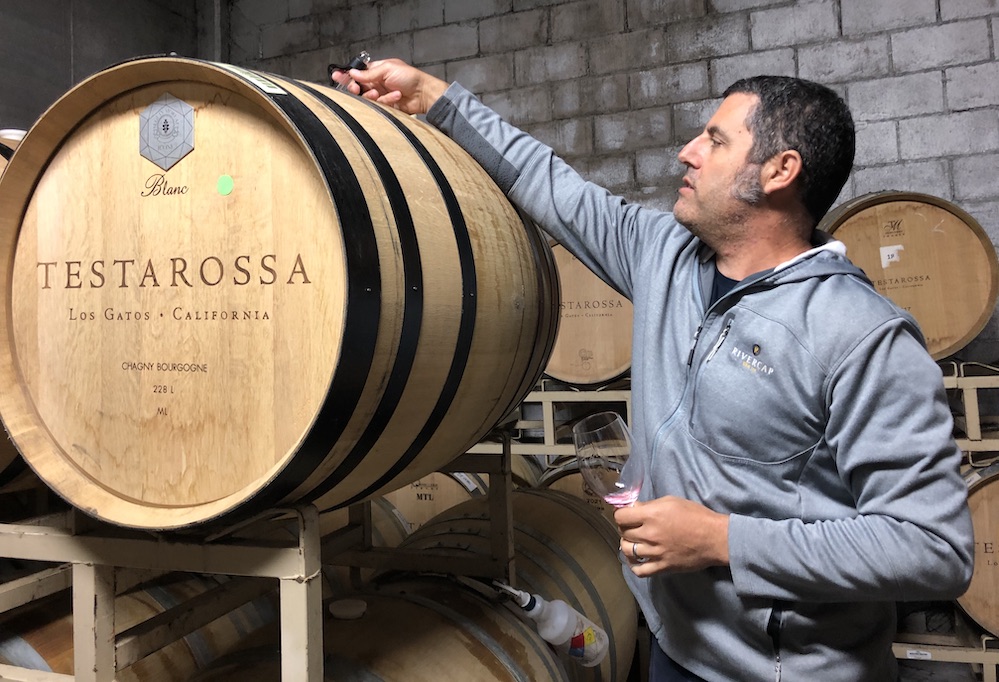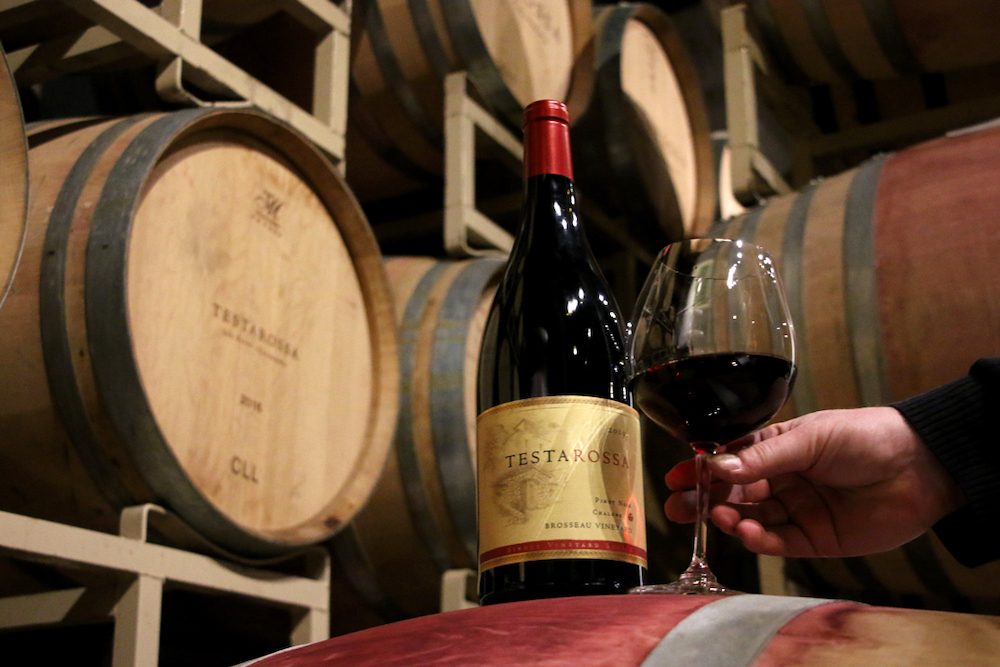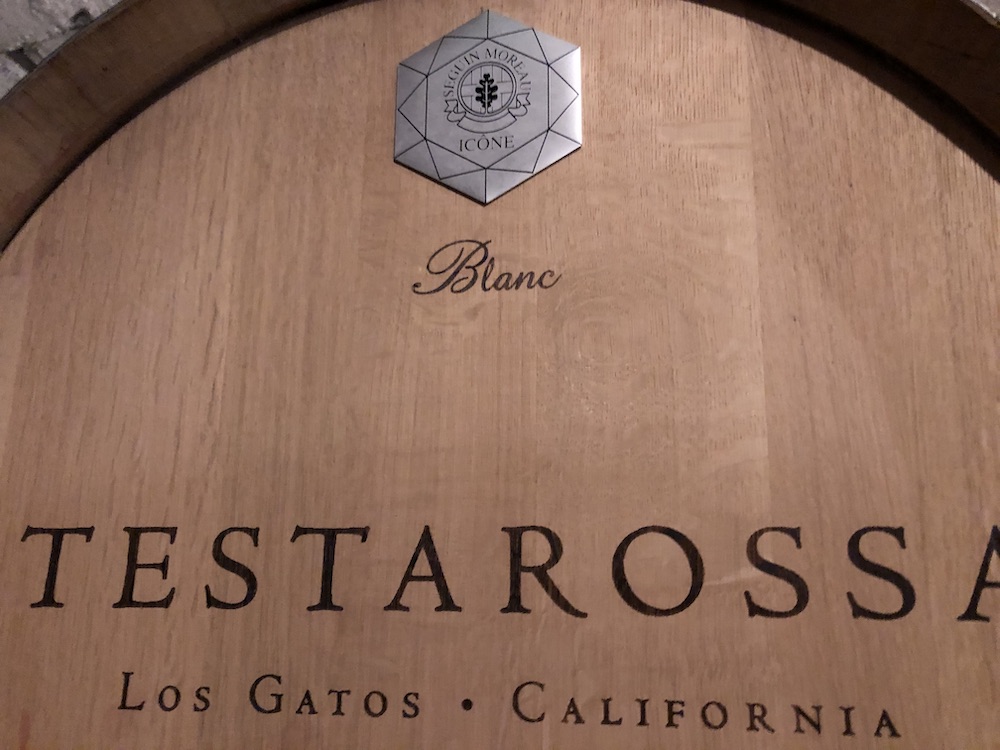
September 22, 2023 – Winemaker Bill Brosseau looked a bit like the Cheshire cat as he thieved us some dark raspberry looking Pinot Noir from one of his favorite vineyards from one of his favorite barrels.
The object of the game was to identify which vineyard the wine came from; it was the replay of a tasting he’d done in mid-August for Testarossa wine club members, to preview the 2022 Pinot Noir vintage. These diehard fans know the vineyards by heart, as they’ve been drinking them for years, and have distinct favorites.
Although vineyards tend to have a signature, the wood the wines are aged in has a major impact, and that was really the subtext of this tasting.
The first barrel sample was brighter in acid and lacked the largesse of anything from the Santa Lucia Highlands, so I toyed with the idea of Santa Maria or Santa Rita Hills, forgetting that Testarossa sources from the Russian River Valley. This turned out to be a Pinot Noir from the Graham Family Vineyard, owned by a longtime friend of the Jensen’s, Howard Graham.
The very straightforward acid-driven and red-fruited profile spoke of a wine picked earlier in the season rather than later. The prolific cinnamon stick aromas are also vineyard-specific, accentuated by the new oak barrel we tasted from: Francois Frere M toast 3-year air-dried. Brosseau says the vines were low yielding and stressed due to the heat of 2022. Still, it’s already telling the tale of the vintage, which featured 10 straight days of temps above 105, and in many vineyards, upwards of 110. Not ideal for growing anything, except for ulcers.
The second barrel sample showed gorgeous raspberry and floral notes, mostly rose petals, with lovely soft tannins and delicate fruit. Turned out to be one of Brosseau’s favorite newer vineyards, Rancho La Vina, in the Sta. Rita Hills AVA. Part of the original Santa Rosa Land Grant, it has been farmed since 1860, beginning with sheep and cattle and then oat hay and lima beans, and is currently planted to 35 acres of Pinot Noir. They also grow walnuts and tomatoes. Resting in a Seguin Moreau barrel, the soft red currant flavors were pristine. When tasted from a Francois Frere VTG M+ barrel, however, the wine seemed overpowered by the dominant lactones from the wood. It will contribute nicely to a blend. Such a difference the barrel makes!

The third sample burst with rich plush cherry, raspberry and chocolate, underpinned by a fascinating chewy texture that hinted at a vineyard of significant horsepower. This turned out to be Soberanes, and was done in a 3-year air-dried Seguin Moreau Premier barrel with Medium Long toast, which is more open-grained and imparts more wood tannins. Being slightly more generous of fruit, Soberanes soaks up the oak.
The fourth barrel sample was again from Soberanes Vineyard, but this time in a Seguin Moreau ICONE barrel, which is actually specially made for white wines. With its less aggressive toast, it allowed the signature citrus oil component associated with the nearby terroir of this vineyard to shine through. Brosseau reminded us that the Soberanes vineyard in the SLH is surrounded by citrus orchards, and just like eucalyptus, citrus trees emanate their oils into the air. So wonderfully integrated was the wine with the barrel, even after such a relatively short time – less than a year – that I was curious how this barrel impacted whites, as intended. So Brosseau grabbed the thief, carefully cleaning it, as he always does, between every use, and we headed for a 2022 Tondre Chardonnay ICONE barrel. The textural smoothness of the wine was stunning: Brosseau likened it to the difference between 200 and 1500 threadcount in linens.
He really loves the nuances of the ICONE barrel and has been using them for 10 years now. Testarossa uses at least 80 different barrels in the cellar, including 20 different permutations of Francois Frere, a very common and much-loved cooperage in the Santa Cruz Mountains and Monterey cellars. But, the ICONE is really special: “It provides a seamless connection with the fruit, like a coat of wax on a fancy sports car,” Brosseau noted.
Obviously as big into metaphors as I am, Brosseau made another analogy about matching the barrel to the wine and keeping it undisturbed, as Testarossa only racks once before bottling.
“It’s like keeping a violin in tune: we try to hold that chord as long as possible. We are OCD about chemistry and cleanliness, but major decisions are informed by how the wine hits our palates, and not by numbers.”
He admits that his career in winemaking has been 20 plus years of “sanitation hell,” but that is the difference between winemaking to a formula and winemaking to achieve the goal of balance and something close to perfection.

We tasted this lush tropical-fruit tinged seamlessly textured Chardonnay while he explained that he has learned to leave the fruit on the vine a bit longer than other winemakers. “I used to be mid-pack, around 22 or 23 Brix, but the average pick keeps going longer. Why cut off the wine’s development?”
We sampled both Pisoni and Garys’ Vineyard Pinot Noirs next, their respective barrel partners being somewhat more bold. Brosseau shared that his approach to Pisoni has changed over the years, as the vines have matured and the fruit has gone from very bold and monstrous to less intense: going from 11 to maybe an 8. Still, this wine, with its spicy rum cherry and dark chocolate cake flavors, can handle what a Francois Frere TG (tight grain) M toast 3-year air-dried barrel can dish out. This has become the “house barrel” for Testarossa.
Garys’ Vineyard is among Brosseau’s favorites for the fusion of clones, soil, site and farming and this barrel sample, with aromas of lemon and orange peel, revealed a wine that despite its power, came across light on its feet, like football players performing ballet. A gorgeous, softer, supple style that seemed remarkably ready to drink.
Among the last of the barrels we tried was a Stanford & Benedict clone of Pinot Noir from Rancho La Vina, which is farmed by Eric Mallea, who also farms Sanford & Benedict, Fiddlestix and La Encantada. Aging in a Seguin Moreau ICONE barrel, this wine was bursting with red cherry, plum, strawberry, red licorice and boysenberry, and absolutely singing with acid. This wine typifies what Brosseau calls tension: that push-pull of acid and fruit that keeps a wine alive and engaging. And far from dull.
What’s remarkable about all these wines is their vibrancy and freshness, and the lack of oak that comes through. All were picked after the big heat wave of Labor Day weekend 2022. It was a wild time, and Brosseau says, “I don’t believe in bringing in hot fruit to a hot crush pad, and subjecting my crew to those kinds of conditions, so we just waited it out. I’ve learned to just let it ride. The vines are remarkable at bouncing back.” The vines shut down over 90 degrees anyway, so letting the fruit stabilize after 10 days of record triple digit heat was critical.
Overall, this strategy seems to have worked out pretty well for Testarossa. One of the primary factors at play here is the tremendous knowledge Brosseau has garnered in working with the vineyards and their managers over his two and half decades. Developing an understanding of the climate, the soils and the way the vines take up water and react to stress is critical to tweaking pruning, hedging, cluster removal, de-leafing and picking decisions.
Brosseau has done a lot of that, as well as a lot of spraying, this year, due to the profound impact of the cool late spring, which made mildew pressure a constant problem for many growers. Unsurprisingly, the first fruit in to Testarossa this year was the Brosseau Chardonnay, from Chalone on September 11, but as we learned from the SLH seminar of Sept 13, it will be a while until the SLH fruit is ready.
Brosseau will just sit tight, waiting it out. The Cheshire cat knows a thing or two.
About the author
Laura Ness is a longtime wine journalist, columnist and judge who contributes regularly to Edible Monterey Bay, Spirited, WineOh.Tv, Los Gatos Magazine and Wine Industry Network, and a variety of consumer publications. Her passion is telling stories about the intriguing characters who inhabit the fascinating world of wine and food.
- Laura Nesshttps://www.ediblemontereybay.com/author/lness/
- Laura Nesshttps://www.ediblemontereybay.com/author/lness/
- Laura Nesshttps://www.ediblemontereybay.com/author/lness/
- Laura Nesshttps://www.ediblemontereybay.com/author/lness/


